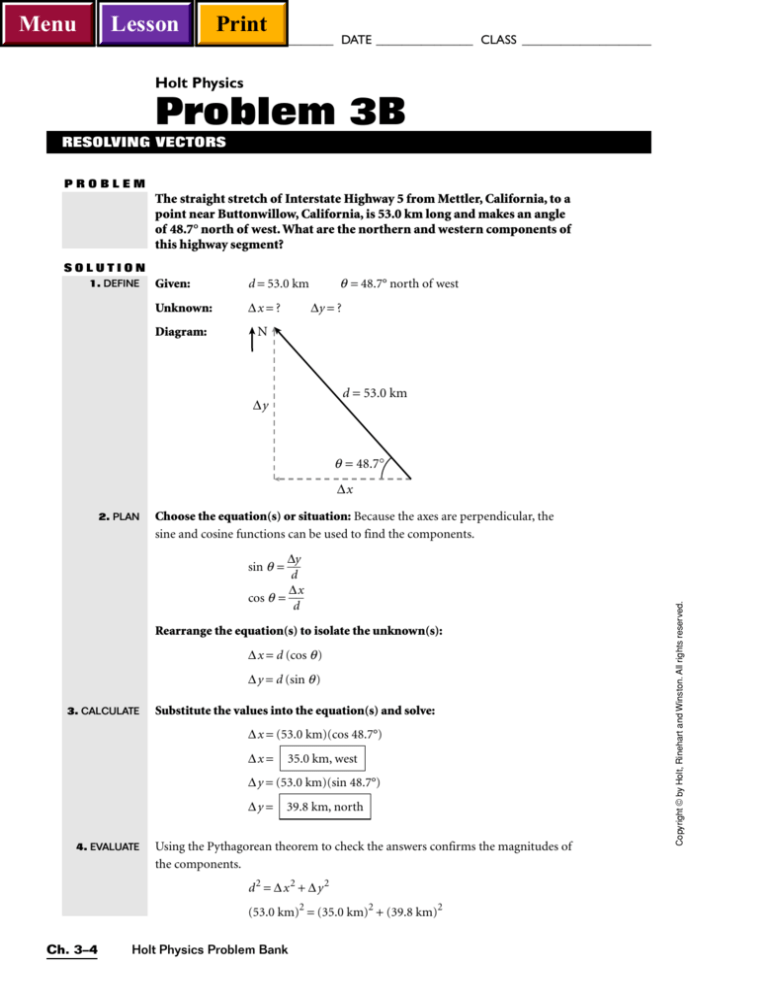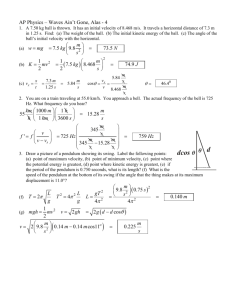
Menu
Lesson
Print
NAME ______________________________________ DATE _______________ CLASS ____________________
Holt Physics
Problem 3B
RESOLVING VECTORS
PROBLEM
The straight stretch of Interstate Highway 5 from Mettler, California, to a
point near Buttonwillow, California, is 53.0 km long and makes an angle
of 48.7° north of west. What are the northern and western components of
this highway segment?
SOLUTION
1. DEFINE
Given:
d = 53.0 km
Unknown:
∆x = ?
Diagram:
N
q = 48.7° north of west
∆y = ?
d = 53.0 km
∆y
θ = 48.7°
∆x
Choose the equation(s) or situation: Because the axes are perpendicular, the
sine and cosine functions can be used to find the components.
∆y
sin q = d
∆x
cos q = d
Rearrange the equation(s) to isolate the unknown(s):
∆x = d (cos q )
∆y = d (sin q)
3. CALCULATE
Substitute the values into the equation(s) and solve:
∆x = (53.0 km)(cos 48.7°)
∆x =
35.0 km, west
∆y = (53.0 km)(sin 48.7°)
∆y =
4. EVALUATE
39.8 km, north
Using the Pythagorean theorem to check the answers confirms the magnitudes of
the components.
d 2 = ∆x 2 + ∆y 2
(53.0 km)2 = (35.0 km)2 + (39.8 km)2
Ch. 3–4
Holt Physics Problem Bank
Copyright © by Holt, Rinehart and Winston. All rights reserved.
2. PLAN
Menu
Lesson
Print
NAME ______________________________________ DATE _______________ CLASS ____________________
2.80 × 103 km2 = 1.22 × 103 km2 + 1.58 × 103 km2
2.80 × 103 km2 = 2.80 × 103 km2
ADDITIONAL PRACTICE
1. The distance from an observer on the plain to the top of a nearby
mountain is 5.3 km, and the angle between this line and the horizontal
is 8.4°. How tall is the mountain?
2. A bowling ball is released at the near right corner of a bowling lane and
travels 19.1 m at an angle of 3.0° with respect to the lane’s length. The
ball reaches the far left corner of the lane, where it knocks over the “7”
pin. What is the width of the lane?
3. A skyrocket travels 113 m at an angle of 82.4° with respect to the ground
and toward the south. What is the rocket’s horizontal displacement?
4. A hot-air balloon descends with a velocity of 55 km/h at an angle of
37° below the horizontal. What is the vertical velocity of the balloon?
5. A billiard ball travels 2.7 m at an angle of 13° with respect to the long
side of the table. What are the components of the ball’s displacement?
Copyright © by Holt, Rinehart and Winston. All rights reserved.
6.
One hole at a certain miniature golf course extends for about 60 m. A golf
ball on this hole travels with a velocity of 1.20 m/s at 14.0° east of north.
What are the eastern and northern components of the ball’s velocity?
7. The Very Large Array in western New Mexico consists of several radio
telescopes that can be rearranged along railroad tracks. The largest of
these arrangements has the telescopes positioned in a “Y” pattern for
18 km along three separate tracks. Suppose an electrician inspects the
instruments in each antenna from the end of the northern track to the
end of the southwestern track. If the electrician’s resultant displacement is 31.2 km at 30 0° west of south, what are the southern and western components of the displacement?
8. Barnard’s Star is the closest star to Earth after the sun and the triple
star Alpha Centauri. Barnard’s Star has a velocity of 165.2 km/s at an
angle of 32.7° away from its forward motion. What are the forward and
side components of this velocity?
9. A tiger leaps with an initial velocity of 55.0 km/h at an angle of 13.0°
with respect to the horizontal. What are the components of the tiger’s
velocity?
10. A certain type of balloon is designed to ascend rapidly. Suppose this
balloon has a velocity 13.9 m/s at 26.0° above the horizontal and 24.0°
east of north. What are the upward, northern, and eastern components
of the balloon’s velocity? (HINT: Draw horizontal and vertical right triangles whose sides represent the velocity’s components.)
Problem 3B
Ch. 3–5
Menu
Lesson
Print
Givens
10. d = 2.9 × 103 km
∆x = 2.8 × 103 km, west
= −2.8 × 103 km
Solutions
d 2 = ∆x 2 + ∆y 2
∆y = d 2−
∆x2 = (2
03km
)2
−(−
03
)2
.9
×1
2.
8×1
∆y = 8.
06km
06km
06km
4×1
2−7.8
×1
2 = 0.
6×1
2 = −800 km
∆y = 800 km, south
∆x
−2.8 × 103 km
q = cos−1 = cos−1
d
2.9 × 103 km
q = 15° south of west
Additional Practice 3B
1. d = 5.3 km
q = 8.4° above horizontal
∆y = d(sin q) = (5.3 km)(sin 8.4°)
∆y = 0.77 km = 770 m
the mountain’s height = 770 m
2. d = 19.1 m
q = 3.0° to the left
∆y = d(sin q) = (19.1 m)(sin 3.0°)
∆y = 1.0 m to the left
the lane’s width = 1.0 m
3. d = 113 m
q = 82.4° above the
horizontal south
4. v = 55 km/h
q = 37° below the horizontal
= −37°
Copyright © by Holt, Rinehart and Winston. All rights reserved.
5. d = 2.7 m
q = 13° from the table’s
length
∆x = d(cos q) = (113 m)(cos 82.4°)
∆x = 14.9 m, south
vy = v(sin q) = (55 km/h)[sin(−37°)]
vy = −33 km/h = 33 km/h, downward
∆x = d(cos q) = (2.7 m)(cos 13°)
∆x = 2.6 m along the table’s length
∆y = d(sin q) = (2.7 m)(sin 13°)
∆y = 0.61 m along the table’s width
6. v = 1.20 m/s
q = 14.0° east of north
vx = v(sin q) = (1.20 m/s)(sin 14.0°)
vx = 0.290 m/s, east
vy = v(cos q) = (1.20 m/s)(cos 14.0°)
vy = 1.16 m/s, north
7. d = 31.2 km
q = 30.0° west of south
∆x = d (sin q) = (31.2 km)(sin 30.0°)
∆x = 15.6 km, west
∆y = d (cos q) = (31.2 km)(cos 30.0°)
∆y = 27.0 km, south
V
Section Five—Problem Bank
V Ch. 3–3
Menu
Lesson
Print
Givens
Solutions
8. v = 165.2 km/s
q = 32.7°
vforward = v(cos q) = (165.2 km/s)(cos 32.7°)
vforward = 139 km/s, forward
vside = v(sin q) = (165.2 km/s)(sin 32.7°)
vside = 89.2 km/s to the side
9. v = 55.0 km/h
q = 13.0° above horizontal
vy = v(sin q) = (55.0 km/h)(sin 13.0°)
vy = 12.4 km/h, upward
vx = v(cos q) = (55.0 km/h)(cos 13.0°)
vx = 53.6 km/h, forward
10. v = 13.9 m/s
vz = v(sin qv) = (13.9 m/s)(sin 26.0°)
qh = 24.0° east of north
vz = 6.09 m/s, upward
qv = 26.0° above the
horizontal
horizontal velocity = vh = v(cos qv)
vy = vh(cos qh) = v(cos qv)(cos qh) = (13.9 m/s)(cos 26.0°)(cos 24.0°)
vy = 11.4 m/s, north
vx = vh(sin qh) = v(cos qv)(sin qh) = (13.9 m/s)(cos 26.0°)(sin 24.0°)
vx = 5.08 m/s, east
Additional Practice 3C
1. d1 = 55 km
∆x1 = d1(cos q1) = (55 km)(cos 37°) = 44 km
q1 = 37 north of east
∆y1 = d1(sin q1) = (55 km)(sin 37°) = 33 km
d2 = 66 km
∆x2 = d2(cos q2) = (66 km)(cos 0.0°) = 66 km
q2 = 0.0° (due east)
∆y2 = d2(sin q2) = (66 km)(sin 0.0°) = 0 km
∆ytot = ∆y1 + ∆y2 = 33 km + 0 km = 33 km
d = (∆
xtot
)2
+(∆
ytot
)2 = (1
)2
+(33
)2
10
km
km
= 1.
04km
03km
04km
21
×1
2+1.1
×1
2= 1.
32
×1
2
d = 115 km
∆ytot
33 km
q = tan−1
= tan−1
∆xtot
110 km
q = 17° north of east
V
V Ch. 3–4
Holt Physics Solution Manual
Copyright © by Holt, Rinehart and Winston. All rights reserved.
∆xtot = ∆x1 + ∆x2 = 44 km + 66 km = 110 km








